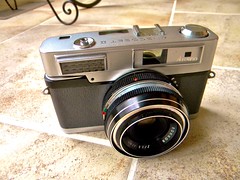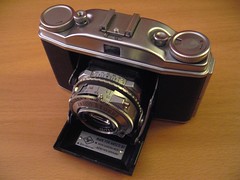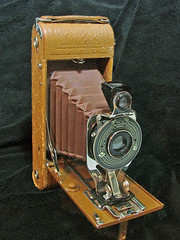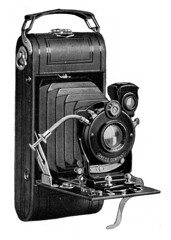Ansco
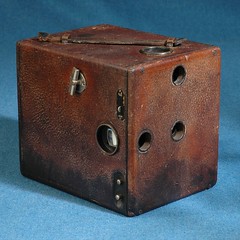
|
| Anthony & Scovill box camera image by PhotoShop Guru (Image rights) |
Ansco was an American manufacturer of camera equipment and film in Binghamton, New York.
In the 19th century its predecessor E. & H.T. Anthony Co. was the largest distributor of photography supply in the U.S.A.. It started in 1841 or 1842 as daguerreotype gallery Edward Anthony in New York and expanded its activity becoming photography supplier in 1847. In 1852 Edward Anthony's brother Henry T. joined. In 1870 the company started making cameras. The company was the first to patent a roll-film holder that could be loaded in light[1].

|
| Ansco ad (click to see on video) image by Eponymous Hero (Image rights) |
In 1902 it was merged with Scovill & Adams into Anthony & Scovill, this name being abbreviated to Ansco. Ansco took over film maker Goodwin, photo paper maker Columbia and the American Photo Products Co.. Then it was acquired by Agfa of Germany in 1928, becoming known as Agfa Ansco (this was a productive period, resulting in many cameras covered in their own article). In addition to new imports and licensing of Agfa products, Ansco also built a new film factory, and in 1939 was renamed General Aniline & Film (GAF). With the entry of the US into WWII, Agfa Ansco was placed under control of the US "Alien Property Custodian," and by 1943 cameras were sold once again simply as Ansco. During the war years production shifted to sextants and military optical rangefinders, and ultimately it was sold as an "enemy asset".
After WWII the company reached its peak as camera maker, with a production of 2 million cameras per year. Beginning in the 1950s Ansco shifted to selling rebadged imports, made by Agfa, Chinon, Ricoh and even Minolta. In 1967 the company began selling its film and cameras under the brand GAF (General Aniline & Film). Then in 1978, Haking of Hong Kong acquired the rights to the Ansco trademark. Simple plastic cameras bearing the Ansco brand after this point are almost certainly Haking products; and typically have "twins" under the Halina and Haking names.

|
| panchromatic film image by Antique Camera Guy (Image rights) |
Ansco cameras continued to be made until the 1990s by Haking, while GAF became Anitec. In 1992 Anitec celebrated the company's 150th anniversary. It became part of a group which was taken over by Kodak. The factory in Binghamton was closed in 1998 and demolished in 2000.
Contents
The Ansconian
From the 1920s through the 1960s, Ansco published a photographic magazine called The Ansconian. The magazine was the descendent of the Anthony Photographic Journal, published by Ansco's predecessor, the E. & H.T. Anthony Co.[2]
Anthony cameras
- Climax Portrait Camera
- Carte de Visite camera
- Solograph (stereo camera)
Ansco cameras

|
| Ansco ad scanned by Kirk Thorsteinson (Image rights) |
| ||
| ||
| ||
| ||
|
35mm film
- Ansco 135 (Haking Halina 150)
- Ansco 1065 (Haking 35mm w/fixed focus 48mm f:8 lens)
- Ansco Anscomark M
- Ansco Anscoset, Anscoset II, Anscoset III (by Minolta)
- Ansco Autoset (by Minolta)
- Ansco Autoset CdS (Minolta)
- Ansco Memar
- GAF Ansco Memo II (half-frame, rebadged Ricoh Auto Half)
- Ansco Pix Panorama (by Haking)
- Ansco Regent
- Ansco Super Memar
- Ansco Super Regent
116 film
116 Box Cameras
- Ansco No. 2A box cameras
- No. 2A
- No. 2A Special
- No. 2A Craftsman
- No. 2A Buster Brown
116 Folding Cameras
- Ansco No. 1A folding cameras
- No. 1A Ready-set
- No. 1A Readyset Royal
- No. 1A Readyset Traveler
- No. 1A Junior
- No. 1A Folding
- No. 1A Speedex
- No. 1A Semi-Automatic
- No. 1A Automatic
- Ansco Junior Model A
- Ansco Shur Shot
118 film
- Ansco No. 3 folding cameras
- No. 3 Junior
- No. 3 Folding
- No. 3 Speedex
120 film
120 Box Cameras
- Ansco No. 2 box cameras
- No. 2
- No. 2 Special
- Ansco Shur Flash
- Ansco Shur Shot
- Ansco Shur Shot Junior
- Ansco Craftsman
- Ansco Craftsman Camera Kit
120 Folding Cameras
- Ansco No. 1 folding cameras
- No. 1 Ready-set Juniorette
- No. 1 Junior
- No. 1 Junior de Luxe
- No. 1 Folding
- No. 1 Expert
- No. 1 Master Ready-set
- No. 1 Special Folding
- No. 1 Speedex
- No. 1 Super Speedex
- Ansco Arrow
- Ansco Commander (6x9)
- Ansco Isolette
- Ansco Marvel S-20 (made for Sears)
- Ansco Readyset Traveler
- Ansco Titan
- Ansco Speedex
- Ansco Super Speedex
- Ansco Viking 6.3
- Ansco Vest Pocket A
- Ansco Vest Pocket 2
120 Solid Body Cameras

|
| 3A Ansco Junior image by Donald Poirier (Image rights) |
122 film
- Ansco No. 3A folding cameras
- No. 3A Junior
- No. 3A Folding
- No. 3A Speedex
- No. 3A Folding Buster Brown
127 film
- Ansco No. 0 Buster Brown Special (box)
- Ansco Dollar Camera (box)
- Ansco Vest Pocket
- Ansco Vest Pocket Ready-set
- Ansco Cadet (127)
- Ansco Cadet II
- Ansco Cadet III
- Ansco Cadet Reflex
- Ansco Lancer
- Ansco Readyset
130 film
- Ansco No. 2C Junior
616 film
- Ansco Clipper
- (Agfa) Ansco Clipper Special
- Ansco Flash Clipper
- Ansco Pioneer (also badged as the "Ansco Jr. Press Photographer")
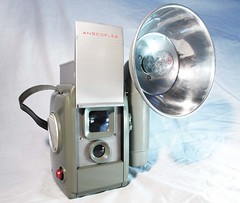
|
| Anscoflex image by vincentnip (Image rights) |
620 film
- Ansco Admiral (variant of Rediflex)
- Ansco Anscoflex
- Ansco Anscoflex II
- Ansco Panda
- Ansco Plenax PB20
- Ansco Readyflash
- Ansco Readyset Special
- Ansco Rediflex
110 film
- Ansco 50 (made by Haking)
- Ansco 204
- Ansco 410
- Ansco 412
- Ansco 501
- Ansco 600 Flash
- Ansco Funpix 110
- Ansco Slim Pix
- Ansco Ultra Compact
- Ansco Vision Twin-Lens
Non-standard 35mm film
Sheet film
Disc film
Presumably all manufactured by Haking; equivalent Halina/Haking models may exist
- Ansco 105, Ansco 105 Telephoto
- Ansco 310
- Ansco 320
- Ansco 330
- Ansco 340
- Ansco 350
- Ansco 370
- Ansco 380 Telephoto
- Ansco 412 Tele-Flash
- Ansco Cadet 100
- Ansco Disc 103
- Ansco Fiesta, Ansco Fiesta Tele
- Ansco HR10, Ansco Memo HR10, Ansco HR10T
- Ansco HR15
- Ansco HR20
- Ansco HR25
- Ansco HR30
- Ansco HR40
- Ansco HR50
- Ansco HR65
- Ansco Ready Flash VR1
GAF cameras
Including Ascomatic models: See article GAF
Notes
- ↑ Coe, Brian, Cameras - from Daguerreotypes to Instant Pictures, Marshall-Cavendish Editions, 1978, p.80
- ↑ Bill Ryan at Ansco
Links
In English:
- about Anthony
- about Ansco
- Public domain Ansco TV commercials at Internet Archive
In French:
